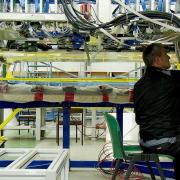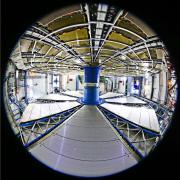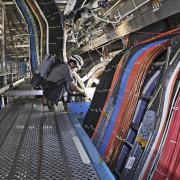Access to Collaboration Site and Physics Results
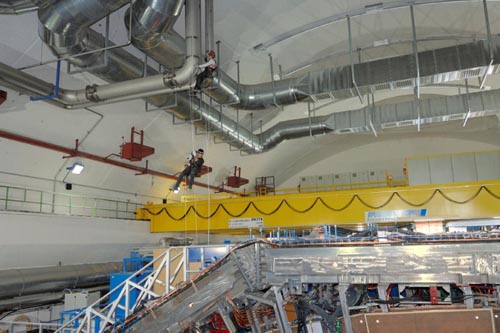
It could be a scene from a James Bond movie. But this action shot of two intrepid rappellers (abseilers) was in fact taken in the ATLAS experimental cavern one night in December. François Butin, the ATLAS experimental area manager, tells the story behind the photograph.
The excavation of the ATLAS cavern began in 2000, but at that time the LHC tunnel, which now opens into the cavern, was still being used by an earlier accelerator (called LEP) and couldn’t be disturbed. “In order not to lose a full year of excavation work we decided to concrete the shallow area we had excavated,” he says. That concrete was later to form the cavern ceiling.
Excavation resumed in 2001 with the removal of the earth beneath the ceiling. “Nobody would build like this normally,” says Butin. “It’s like building the roof of your house before the walls.” To prevent the concrete ceiling from collapsing as the excavation work continued, it was secured with cables to small anchoring galleries in the two access shafts that connect the cavern to the surface. Four galleries - two in each shaft - were used to support the entire cavern ceiling.
The excavation work proceeded well and the ATLAS collaboration took possession of the cavern in 2003. But a problem soon emerged. “A water leak appeared in an anchoring gallery in Side A,” says Butin. “We tried to inject resin to plug the leak, but after a while the leak appeared somewhere else.”
Instead of trying to fix the leak, Butin’s team decided to find a use for the water. “We put in a drain and drained the water to the bottom of the cavern where it has been used in the toilet system,” says Butin. “So in the end, it was actually pretty useful! It leaked beautifully for a couple of years and suddenly in 2005, the water stopped flowing for no obvious reason.”
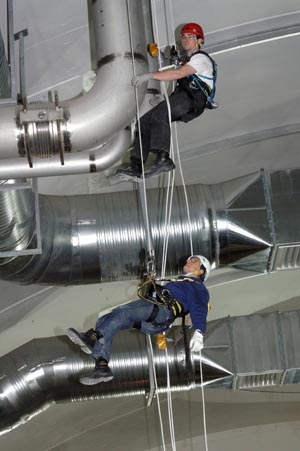

The leak is likely to reappear after a period of heavy rain, and Butin says it is important that the drain is still in good working condition to prevent water raining down onto the detector below. But checking the formerly leaking gallery is difficult, because it lies some 40 metres down one of the access shafts. Rappelling offered the most practical solution to the access problem.
On a dark night in December, a professional rappelling team trained Butin and his colleague, Bernard Lebegue, in the techniques needed to descend the shafts. “It was a great experience,” says Butin. “First, both professionals went down together to check that the ropes were the right length and that there were no specific problems. Then I went down with one professional.” The team dropped down about 40 metres and squeezed between two of the big pipes - a space of about 40 cm - to land on a small flat surface in front of the anchoring gallery.
“Our first task then was to unbolt the metallic covering plate,” says Butin. “But then there was a problem. I suspected that there might be some residual gases in the closed gallery so we had equipped ourselves with oxygen deficiency hazard meters.” As soon as Butin entered the gallery, the meter sounded a low oxygen warning and he quickly withdrew. The team was still able to clean the drain outside the gallery, but the oxygen level within remained too low for either team to enter the anchoring gallery and find the source of the leak.
But the drain cleaning exercise was a success, and an exciting experience, says Butin. ”I cannot say it was scary, because we are used to working at height, but it was very different from what we do normally. You’re more concerned with doing damage to the access shaft - a small chip of concrete could fall and damage the detector.”
The exercise was as much a novelty for the professional rappellers as it was for the ATLAS workers, and a photographer who specialises in photographing rappellers documented the event. “The company that makes our hard hats and abseiling equipment even want to use the pictures in their advertisements!” says Butin.


